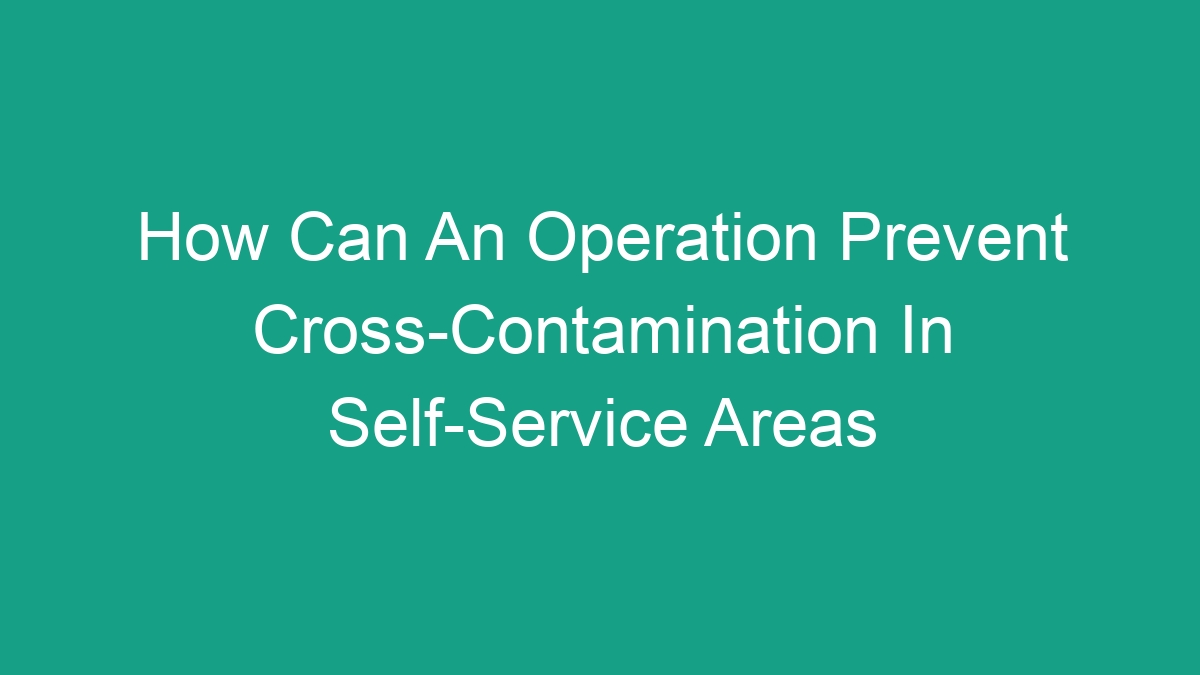
The Importance of Preventing Cross-Contamination
Cross-contamination occurs when bacteria and viruses are transferred from one object or surface to another. In the context of self-service areas such as buffets, salad bars, and food courts, the risk of cross-contamination is particularly high. This is because multiple people handle serving utensils, plates, and other items, creating opportunities for the spread of harmful pathogens.
Preventing cross-contamination is crucial for the health and safety of patrons and staff. If not properly managed, it can lead to foodborne illnesses, which can result in serious health complications and damage the reputation of the operation. Additionally, in the current global climate, the prevention of cross-contamination has taken on even greater significance, as businesses strive to maintain a safe and hygienic environment to prevent the spread of infectious diseases such as COVID-19.
Implementing Effective Cross-Contamination Prevention Strategies
1. Designing the Layout and Flow of the Self-Service Area
The layout of the self-service area plays a significant role in preventing cross-contamination. Operations should aim to create a logical flow that directs patrons through the serving areas in a manner that minimizes the potential for contamination. This can include ensuring that the flow of traffic moves in one direction to reduce instances of patrons crossing paths and touching multiple surfaces.
Additionally, the placement of different food items and serving utensils should be strategically organized to minimize the risk of cross-contamination. For example, raw and cooked foods should be placed in separate areas, and utensils for each should be spaced apart to prevent them from coming into contact with each other.
2. Implementing Proper Cleaning and Sanitization Protocols
Regular and thorough cleaning is essential in preventing cross-contamination in self-service areas. All surfaces that come into contact with food or serving utensils should be cleaned and sanitized frequently. This includes countertops, serving trays, sneeze guards, and any other surfaces that patrons may touch.
In addition to routine cleaning, the operation should have protocols in place for responding to spills and other messes promptly. Staff should be trained to recognize and address potential sources of contamination immediately to prevent the spread of pathogens.
3. Providing Protective Barriers and Hygiene Stations
The installation of clear protective barriers, such as sneeze guards, can help prevent the spread of airborne contaminants in self-service areas. These barriers act as a physical barrier between patrons and the food, reducing the risk of respiratory droplets landing on the food or serving utensils.
Moreover, offering hand sanitizer stations at various points within the self-service area encourages patrons to practice good hand hygiene before handling serving utensils or touching communal surfaces. By providing access to hand sanitizer, operations can help reduce the risk of cross-contamination through contact with contaminated hands.
4. Training and Educating Staff
Staff training is crucial in ensuring that proper cross-contamination prevention measures are consistently implemented. All employees who work in the self-service area should receive comprehensive training on food safety, hygiene practices, and the specific protocols and procedures outlined by the operation. This training should emphasize the importance of preventing cross-contamination and provide practical guidance on how to do so effectively.
Furthermore, ongoing education and reinforcement of best practices are essential to maintain a high standard of hygiene and safety. Regular refresher training sessions and communication of updates to protocols can help keep staff vigilant and informed about the latest developments in cross-contamination prevention.
Utilizing Technology to Minimize Contact
1. Implementing Contactless Payment Options
In addition to preventing the spread of contaminants through food and surfaces, operations can also minimize contact between patrons and staff by implementing contactless payment options. By offering touchless payment methods such as mobile payments or card tapping, the need for physical contact at the point of sale is reduced, thereby further minimizing the risk of transmission.
2. Introducing Digital Menu Boards and QR Code Ordering
To limit physical contact with menus and ordering kiosks, operations can deploy digital menu boards and QR code ordering systems. Patrons can simply scan a QR code with their smartphone to access the menu and place their order, eliminating the need to handle physical menu cards or interact directly with staff. This not only reduces the risk of cross-contamination but also enhances the overall efficiency and convenience of the ordering process.
Compliance with Regulatory Standards and Guidelines
1. Staying Informed About Food Safety Regulations
It is essential for operations to stay informed about and comply with relevant food safety regulations and guidelines issued by local health authorities. These regulations often provide specific requirements and recommendations for preventing cross-contamination, and adherence to them is crucial for maintaining a safe and hygienic self-service environment.
2. Regular Monitoring and Auditing of Hygiene Practices
Regular monitoring and auditing of hygiene practices can help identify areas for improvement and ensure that the operation is consistently meeting or exceeding regulatory standards. This can involve internal hygiene audits, as well as third-party assessments, to provide an objective evaluation of the operation’s performance in preventing cross-contamination.
Conclusion
Preventing cross-contamination in self-service areas is a multifaceted endeavor that requires careful planning, strict adherence to hygiene protocols, and ongoing vigilance. By designing the layout and flow of the self-service area strategically, implementing proper cleaning and sanitization protocols, providing protective barriers and hygiene stations, offering staff training and education, utilizing technology to minimize contact, and ensuring compliance with regulatory standards, operations can effectively mitigate the risk of cross-contamination and create a safer, more hygienic environment for patrons and staff. As the understanding of infectious diseases continues to evolve, it is imperative for operations to remain adaptable and proactive in their approach to cross-contamination prevention. Through the implementation of comprehensive and effective strategies, operations can safeguard the health and well-being of all individuals who interact with their self-service areas.



